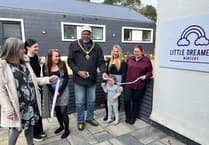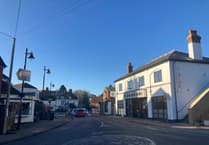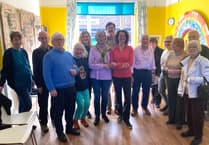Peter Goodman of the Farnham Cycling Campaign last week (Herald, March 16) published a “map showing possible routes across Farnham which could be used to construct an initial network of cycle tracks”.
He also stated: “These cycle tracks would not require the closure of any car lanes but would allow a lot of people to get into Farnham town centre by leaving their car at home if they live close enough.”
However, are these viable routes or simply desire lines?
There are several walking desire lines, which are currently heavily used in Farnham where local councillors are campaigning for better crossings and struggling to get funding.
For example, the northern arm of the Water Lane roundabout on the A325 to the Six Bells roundabout, which recently scored highest in a review of road safety schemes in Surrey, but isn’t being done because the cost is too high for the scheme.
Or the top of Castle Street by the castle where the sight lines are causing the Surrey Highways team to say the location doesn’t meet their design requirements.
The list of walking desire lines improvements is far too long to cover in full.
What about existing pavement quality? Again, your local councillors have been trying hard to get the pavement widths increased in areas where widths are currently significantly below required standard, placing pedestrians in increased danger, particularly on key walking routes to local schools and in the town centre; the design guidance requires a minimum of two metres width.
Again, the list of where pavements are either non-existent or less than one-metre wide is far too long to include here.
Peter Goodman would have you believe his cycling routes are not only viable but essential and have absolutely no negative impacts. The Highway Code puts pedestrian safety at the top of the list and the Surrey Local Transport Plan puts pedestrians at the top of the sustainable travel hierarchy, followed by cycling/scooting and then e-bikes.
One of the five core design principles covered in LTN 1/20 (the much-quoted design Cycling Infrastructure Design Guide) states: “Infrastructure must be accessible to all and the needs of vulnerable pedestrians and local people must be considered early in the process.”
It also states: “The ability to deliver a right to cycle requires infrastructure and routes which are accessible to all regardless of age, gender, ethnicity or disability and does not create hazards for vulnerable pedestrians. Improvements to highways should always seek to enhance accessibility for all.”
The protection of vulnerable pedestrians is a key concern for many local councillors; finding the right solutions for our town mean balancing many priorities and the right answers are far from simple. Campaign groups are loud and narrowly focused by their very nature, but we must as councillors listen to all the voices, not just the loudest.
One proposed cycle route is through the middle of the new Brightwells development, a designated pedestrian zone. LTN 1/20 states: “Shared use routes in streets with high pedestrian or cyclist flows should not be used.”
I encourage everyone to take an actual walk through the newly-constructed development and try to find a route that will not create conflict between pedestrians and cyclists. This proposed route is not LTN 1/20 compliant as it will “create hazards for vulnerable pedestrians”.
In a previous version of his map, Peter Goodman had cyclists travelling along the HGV access road serving Brightwells and then along other narrow existing pedestrian routes, also clearly not appropriate, creating dangerous conflicts for vulnerable pedestrians.
Do the routes on Peter Goodman’s map likewise corroborate his statement that “they don’t require the closure of any car lanes”, and do they really have no negative impacts? The logical answer is no; there are already issues on the included arterial routes, which have been raised to him, but he appears to refuse to accept.
Looking at just one – the proposed route along Folly Hill/western edge of Farnham Park then through Farnham Park: Folly Hill is a narrow, busy road, the A287, with a narrow pedestrian route running alongside. So where would the cycle lane go? There isn’t space on the road or on the existing footway.
If there are to be no closures of any car lanes, then the proposal appears to require the use of Grade II-listed Farnham Park for the whole route from north to south, passing through areas of high ecological and archaeological sensitivity, then using the existing heavily-used diagonal pedestrian route through the park.
Again, this is in direct conflict with the core principles of LTA 1/20 by creating serious hazards for vulnerable pedestrians, plus creating significant damage to Farnham Park. There is also a national priority to improve biodiversity with all developments and this route will not do this.
I have asked the cycling campaign for viable routes several times. Each time, I get desire lines instead.
Sadly, the whole process of developing local cycling and walking routes leads to the selection of routes along main roads in the first phase, leaving the detailed design phase to look at routing constraints and conflicts between cycling and walking routes.
We can all agree the town needs pedestrian and cycling improvements to encourage residents to walk and cycle rather than using the car, coupled with much better public transport, while also finding a way to keep the traffic moving.
There are no easy answers and continuing to just draw desire lines on a map that conflict with standards and regulations isn’t either constructive or helpful.
Other councillors and I are working hard to ensure the Farnham Infrastructure Programme design team takes all users into account and the right balance is found for our town and, most importantly, nothing we do creates hazards for vulnerable pedestrians.
The first map (above) shows Peter Goodman’s desire lines and some of the conflicts plus some possible alternative routes that have been proposed by councillors.
The second map (below) shows veteran trees in Farnham Park that must be protected as part of any improvements for walking and cycling; many trees are hundreds of years old and support significant biodiversity.

My ambition is to find integrated solutions that work for all and protect the environment.
We all want viable new cycle routes that will not create hazards for vulnerable pedestrians, nor involve destroying veteran trees or valuable habitats. Therefore, I would welcome new viable routes being brought forward beyond simple desire lines on a map.




